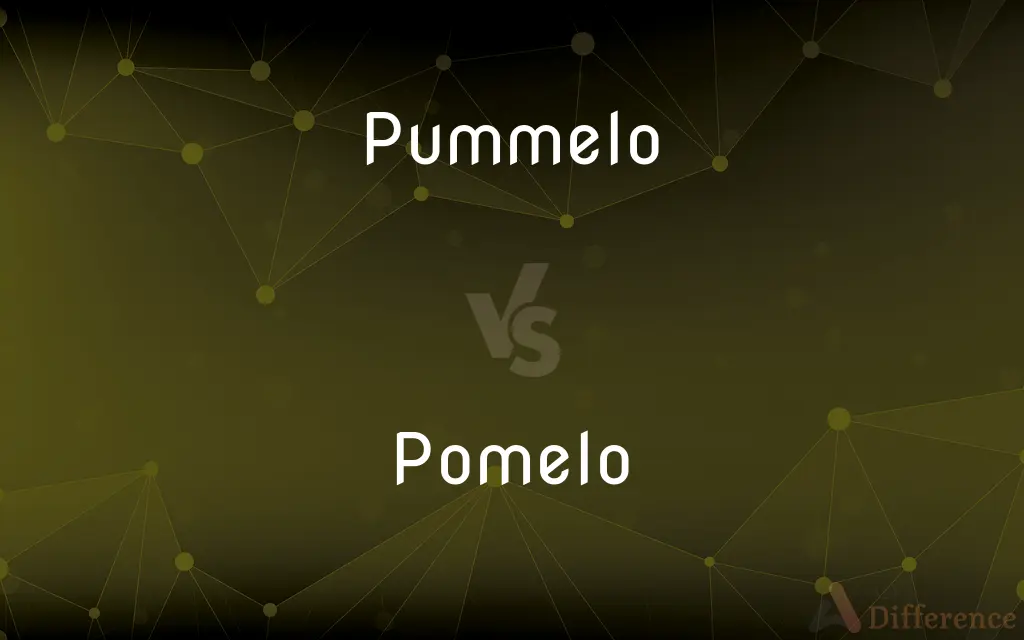Pummelo vs. Pomelo — What's the Difference?
By Tayyaba Rehman & Maham Liaqat — Updated on March 22, 2024
Pummelo and pomelo refer to the same fruit, the largest citrus fruit, with slight variations in name due to regional language differences. Both terms are used interchangeably.

Difference Between Pummelo and Pomelo
Table of Contents
ADVERTISEMENT
Key Differences
Pummelo and pomelo are two terms that refer to the same citrus fruit, scientifically known as Citrus maxima or Citrus grandis, which is the largest of the citrus family. The variation in naming is largely due to regional and linguistic differences, rather than differences in the fruit itself. Both names are accepted and used interchangeably in different parts of the world.
The fruit is known for its thick, green or yellow rind and sweet, mildly tangy flesh, which can vary in color from white to pink or red. While "pummelo" is an older spelling that reflects its etymological origins, "pomelo" has become more widely used in many English-speaking countries. The distinction in spelling does not denote any significant difference in the fruit's characteristics, cultivation, or culinary uses.
Both pummelo and pomelo are enjoyed fresh and are often used in salads, desserts, and beverages in the cuisines where they are common. They are also valued for their nutritional benefits, including vitamin C, potassium, and dietary fiber. The fruit's large size and sweet, less acidic flavor distinguish it from other citrus fruits like oranges and grapefruits.
In terms of botanical classification and culinary application, there is no difference between pummelo and pomelo. The choice of term often depends on regional preferences or the influence of colonial languages on local lexicons. For example, "pomelo" is more commonly used in American and British English, reflecting contemporary linguistic trends.
Comparison Chart
Name Origin
Older spelling reflecting etymological origins.
More commonly used in contemporary English.
ADVERTISEMENT
Usage
Interchangeable with pomelo.
Interchangeable with pummelo.
Fruit Description
Largest citrus fruit, with thick rind and sweet flesh.
Identical to pummelo in all botanical and culinary aspects.
Regional Preference
Some regions may prefer this spelling due to traditional reasons.
Preferred in many English-speaking countries due to linguistic trends.
Culinary Uses
Used in salads, desserts, and beverages.
Same as pummelo, with no difference in use or flavor.
Compare with Definitions
Pummelo
Often used in traditional cuisines for its unique flavor.
The recipe calls for pummelo juice to add a tangy sweetness.
Pomelo
The more commonly used term for Citrus maxima. with identical characteristics to pummelo.
He preferred the sweet taste of pomelo in his morning smoothie.
Pummelo
Valued for its nutritional content. including vitamin C.
Pummelos are a great source of vitamin C and fiber.
Pomelo
A versatile fruit used in a variety of dishes.
The salad featured thinly sliced pomelo for a refreshing taste.
Pummelo
An older term for the largest citrus fruit. known for its thick rind and sweet flesh.
She added chunks of pummelo to the fruit salad for a citrusy burst.
Pomelo
Its usage reflects contemporary linguistic trends. especially in English-speaking countries.
Pomelo has become a popular ingredient in modern cuisine.
Pummelo
The fruit's large size makes it distinctive among citrus.
The pummelo is so large that it can feed a whole family.
Pomelo
Known for its significant size and delicious. sweet flesh.
The pomelo. with its sweet flesh. was the highlight of the dessert.
Pummelo
Pummelo" in certain regions. reflecting linguistic heritage.
The market had a special on pummelos this week.
Pomelo
Offers the same nutritional benefits as its counterpart.
Adding pomelo to your diet can boost your intake of essential nutrients.
Pummelo
Variant of pomelo.
Pomelo
The pomelo (), pummelo (), or in scientific terms Citrus maxima or Citrus grandis, is the largest citrus fruit from the family Rutaceae and the principal ancestor of the grapefruit. It is a natural, i.e., non-hybrid, citrus fruit, native to Southeast Asia.
Pummelo
Alternative spelling of pomelo
Pomelo
The largest of the citrus fruits, with a thick yellow skin and bitter pulp which resembles grapefruit in flavour.
Pummelo
Southeastern Asian tree producing large fruits resembling grapefruits
Pomelo
The tree which bears the pomelo.
Pomelo
A tropical Southeast Asian tree (Citrus maxima) closely related to the grapefruit and having very large round fruit with a thick rind and coarse-grained pulp.
Pomelo
The edible yellow fruit of this tree. In both senses also called shaddock.
Pomelo
The large fruit of the Citrus maxima (syn. Citrus grandis), native to South Asia and Southeast Asia, with a thick green or yellow rind, a thick white pith, and semi-sweet translucent pale flesh.
Pomelo
The tree which produces this fruit.
Pomelo
The grapefruit.
Pomelo
A variety of shaddock, called also grape fruit.
Pomelo
Southeastern Asian tree producing large fruits resembling grapefruits
Pomelo
Large pear-shaped fruit similar to grapefruit but with coarse dry pulp
Common Curiosities
Why are there two names for the same fruit?
The two names arise from the fruit's etymological history and the influence of different colonial languages on regional lexicons.
Is there any nutritional difference between a pummelo and a pomelo?
No, they are the same fruit and thus have identical nutritional profiles, including high levels of vitamin C and dietary fiber.
Can I use pummelo and pomelo interchangeably in recipes?
Yes, since they refer to the same fruit, they can be used interchangeably in any culinary preparation.
Which term should I use, pummelo or pomelo?
The choice between pummelo and pomelo can depend on regional preferences or the most common usage in your area or the context in which you are writing or speaking.
Can the peel of pummelo/pomelo be used?
Yes, the thick peel can be candied or used in cooking for its aromatic oils and flavor.
How do I select a good pummelo/pomelo at the market?
Look for fruits that are heavy for their size, with a firm but slightly soft rind, indicating ripeness.
Are pummelos/pomelos related to grapefruits?
Yes, pummelos are considered the ancestors of grapefruits, with grapefruits being a hybrid of pummelos and oranges.
What is the main difference between pummelo and pomelo?
There is no main difference; pummelo and pomelo refer to the same fruit, with variations in spelling due to regional language differences.
How do I store a pummelo/pomelo?
They can be stored at room temperature for a few days or in the refrigerator to extend their shelf life.
How do you eat a pummelo/pomelo?
The fruit is usually cut into halves or quarters, and the flesh can be separated from the peel and eaten directly or used in dishes.
Can pummelo/pomelo be grown in a home garden?
Yes, in suitable climates, pummelo/pomelo trees can be grown in home gardens, requiring warm temperatures and sunny conditions.
Is pummelo/pomelo available year-round?
Availability can vary depending on the region, but they are typically harvested in late fall and winter.
What dishes can I make with pummelo/pomelo?
It's used in salads, desserts, drinks, and savory dishes, often adding a fresh, citrusy element.
Is the pummelo/pomelo seedless?
Some varieties have few to no seeds, while others may contain seeds.
How does the taste of pummelo/pomelo compare to other citrus fruits?
It's sweeter and less bitter than grapefruit, with a mild, tangy flavor that's less acidic than that of oranges.
Share Your Discovery

Previous Comparison
Specify vs. Indicate
Next Comparison
Just vs. RightAuthor Spotlight
Written by
Tayyaba RehmanTayyaba Rehman is a distinguished writer, currently serving as a primary contributor to askdifference.com. As a researcher in semantics and etymology, Tayyaba's passion for the complexity of languages and their distinctions has found a perfect home on the platform. Tayyaba delves into the intricacies of language, distinguishing between commonly confused words and phrases, thereby providing clarity for readers worldwide.
Co-written by
Maham Liaqat














































